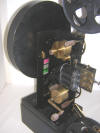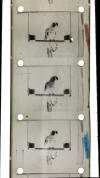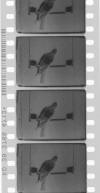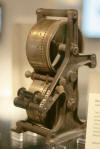Lee-Turner Project with the National Media Museum
- the world's first colour moving images
The project was instigated by Michael Harvey - Curator of Cinematography at the National Media Museum, Bradford and funded by Screen Yorkshire.
We are grateful for the assistance and facilities provided by the Conservation Specialists at the bfi/National Archive through the good offices of Charles Fairall, Head of Conservation.
There is a display at the National Media Museum at Bradford of various artefacts such as the projector and perforator, you can see the films.
Here is a link to the Youtube video
Frederick Marshall Lee was the financial backer of Edward Raymond Turner. They were the first to produce moving colour pictures. Other people had suggested various systems but Turner used his system to actually shoot film. Their perforator and projector are at the National Media Museum in Bradford, UK; they were made by Alfred Darling in Brighton. The NMM also hold most of the film shot by Lee-Turner. The film was shot as 1½ inches wide although due to the shrinkage that takes place with nitrate film during processing the processed film is 1 15/32 inches wide. It is usually maintained that the film was shot at 48 frames per second but examination of the film indicates that it was shot at around 16 frames per second. This confusion seems to stem from the fact that you were looking at three frames at a time, however the projector pulls down one frame at a time and the colour images look correct at 16 fps.
Lee and Turner patented the process in 1899 ,patent number: GB189906202A
The patent appears by kind permission of:
The Director European Patent Office EPA/EPO/OEB 80298 Munchen Deutschland Espacenet Home Page
The film was shot using red, green and blue filters sequentially. The positive film was projected using a projector with three lenses which superimposed three frames at a time through a rotating filter with red green and blue filters. You first viewed (as an example) frame 1 through a red filter, frame 2 through a green filter and frame 3 through a blue filter simultaneously. The projector pulled down the film one frame; the filter wheel rotated and you viewed frame 2 through a green filter, frame 3 through a blue filter and frame 4 through a red filter and so on. Unfortunately Turner was unable to achieve steady, satisfactorily registered pictures with his projector. After he died further attempts to make the system work by Urban and George Albert Smith were unsuccessful.
Illustrations
Pictures from left :to right (click thumbnail to enlarge)
Lee-Turner projector
Michael Harvey with the projector
Digital composition from copied original
Original 1 ½ inch film with crayon marks to indicate which frame is which colour
First test printing
Digital composition from another set of frames note, the fringing caused by movement of the subjects between taking the red, green and blue frames. This is known as time -parallax error
David Cleveland and Brian Pritchard printing at the National Archive printing the originals
Gate containing frame
Perforator built by Alfred Darling - on display at the National Media Museum, Bradford.
Biographical Details
Edward Raymond Turner was born in 1873 in Clevedon, Somerset, according to the 1891 census. He married Edith Mary Gardener on the 2nd May 1895 at Holy Trinity, Hounslow. They had three children Agnes May born in 1896, Alfred Raymond born in 1899 and Wilfred Sydney born in 1902.
Turner died of a heart attack in his workshop in 1903. He was buried in Hounslow on the 12th March 1903.
Lee had withdrawn his financial backing and Turner sold all of his equipment and the patents to Charles Urban who then employed George Albert Smith to make the system work after the death of Turner. Smith was unsuccessful and he then went on to work on Kinemacolor.
There is some argument as to who the children are and where the film was shot and by whom. George Albert Smith had 2 children according to the 1901 census, Harold aged 11 and Dorothy aged 10. It seems likely that the frames showing 3 children are Turner's children and were probably shot in the gardens of Turner's house at 8 Queen's Road, Hounslow..
Details of the Project
David Cleveland and myself had been asked by the NMM to copy the film so that it can be seen. We built a gate to take the 1½ inch film and copied it frame by frame on a Nielsen-Hordell optical printer at the bfi/National Archive. It was a very time consuming process as each frame has to be placed in the gate by hand before being photographed. It took about an hour to copy 100 frames. We were determined to copy the film back onto 35mm polyester film so that it could be preserved long term; there is always a danger that digital files will disappear or not survive. The longevity and permanence of digital files has not yet been established.
Once we had copied all the frames they had to be combined to produce colour pictures. This can be done relatively easily by digital methods - the samples above were made using scans and Photoshop 7.0 to combine the images. The 35mm duplicates were scanned at 4K resolution on an Arriscan and then digitally combined using Smoke software. It is also hoped to combine the images photographically - time and funding permitting.
The major problems with the system were time-parallax errors caused by shooting the frames sequentially and the difficulty in lining up the three lenses during projection. The three lenses were used so that three frames could be projected simultaneously to try to minimise the time-parallax errors and also to eliminate the flashing caused when sequential frames are projected sequentially through red, green and blue filters.
Most book references to the film mention that it was projected at 48 frames per second ,we are convinced that this was not so; we estimate that they were projected at 16 frames per second. Viewing the frame by frame copies the films look correct at 16fps. The confusion seems to arise because three frames were shown at a time on the Lee-Turner Projector but the projector pulled down 1 frame at a time. At 48 frames a sec some of the test films would only last 2 secs and from the videos you can see that they last much longer.
David Cleveland explains why we chose
to copy the film back on to film
To
reproduce the Lee Turner film in colour first we decided to copy each frame of
the original nitrate film on to modern 35mm black and white film stock. There
were a number of reasons for starting the process this way. First the positive
nitrate film was one hundred and nine years old when we began work. Whether it
would last another century was something we had to take into consideration. It
has survived remarkable well, but had shrunk slightly. Copying onto 35mm fine
grain duplicating stock kept the sequential nature of the original Turner
process. In this way, should the nitrate decompose with time, a near as
possible replica of the original process will exist. We realise this is 35mm
and not 1½ inch wide film with two
circular perforations per frame, but to make a reproduction of the original
celluloid was not really possible.
For
researchers and historians it is important to be able to examine original
materials to see how they were made and worked, and with this approach we have
gone a little way to achieve this – by having a film of the successively taken
frames in the original order, complete with blemishes from the original which
give information to the archivist. This method of a 35mm dupe negative
safeguarded the original Lee Turner film so that it was not subjected to
running through a machine, (even if such a scanner was available to take the
unusual size film and perforation) and was protected from any strains and
stresses that might possibly occur.
They
other important reason is that probably sometime in the future further
restorations will be contemplated, and if the original has deteriorated, then
the 35mm may provide a master to work from. Modern safety film, if well stored
and looked after, will last a century at least.
We
have tried to keep as near as possible to Turner’s original idea of what the
film would have looked like on a screen. Yes, further work could be done to
make the colour pictures clean and tidy like a perfect television picture we
see today, but that is not what we wanted to do – though we have made provision
for further possible like work to be done from the new master at any time. The
original films were not intended to be shown on a small screen in the way we
are used to today.
It
was our intention to adhere as far as possible to Turner’s plans, so that we
can see the images projected onto a screen as near as possible to what Turner’s
method would have produced at the time – what people would have seen if the
system had worked commercially. There is always a danger that digital files
will disappear or not survive. The longevity and permanence of digital files
has not yet been established.
The Films:
There are 10 rolls of film and 4 short sections, two of which are prints which have been tinted blue, perhaps as an experiment to improve colour reproduction.
Blue tinted positive
Negative Films
Parrot - 207 frames
Goldfish Bowl - 162 frames
Street scene with horse drawn buses - 124 frames
Soldiers matching - 140 frames
Children at table with goldfish bowl - 133 frames
Parrot wider shot - 195 frames
Girl on Swing - 97 frames
Positive Films
Pier to street scene Brighton? This is a tracking shot - 462 frames
Test Roll; Parrot, Boy and Girl on Swing with Flag, Children with goldfish bowl, Parrot. The final parrot section appears to be a number of prints of the same section.- 4072 frames
Parrot - 164 and 78 frames
Total 5831 frames.








